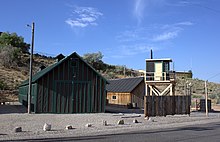
Back רצח השבויים הגרמנים ביוטה HE 真夜中の虐殺 Japanese Массовое убийство военнопленных в Селайне (Юта) Russian
| Utah prisoner of war massacre | |
|---|---|
| Part of the American theater of World War II | |
 Camp Salina in 2018 | |
 | |
| Location | Salina, Utah, United States |
| Coordinates | 38°57′28″N 111°50′52″W / 38.95767°N 111.84777°W |
| Date | July 8, 1945 12:00 midnight (MST) |
| Target | German prisoners of war |
Attack type | Mass shooting War crime |
| Weapons | .30 caliber M1917 Browning machine gun |
| Deaths | 9 |
| Injured | 19 |
| Perpetrator | Clarence V. Bertucci |
| Motive | Anti-German sentiment |
The Utah prisoner of war massacre (headlined by Time as Midnight Massacre[1][2]) took place after the end of World War II in Europe at midnight on July 8, 1945, at a German and Italian prisoner-of-war camp in Salina, Utah. Nine German prisoners of war were murdered and nineteen prisoners were wounded by American private Clarence V. Bertucci, who was on active duty in the camp. After a night out, Bertucci returned to camp around midnight to assume his night duty at the guard tower. Bertucci subsequently loaded the .30-caliber M1917 Browning machine gun on the tower and fired at the tents of the sleeping prisoners. After the massacre, he revealed his motivation was that, "he had hated Germans, so he had killed Germans." Six Germans were immediately killed, two died in Salina's hospital, one died in an army hospital, and nineteen were wounded.
The victims were buried with full military honors at the Fort Douglas Cemetery. Wounded prisoners were sent back to Germany after they were healthy enough to travel. After the massacre, Bertucci was taken into custody with minimal resistance. He was evaluated for a few weeks, before doctors determined that he was "mentally unbalanced". Military officers forwent a court-martial on account of insanity and he was sent to Mason General Hospital in New York for an undisclosed amount of time. The Midnight Massacre is remembered for being "the worst massacre at a POW camp in U.S. history". A museum was opened at Camp Salina in 2016.
- ^ Luce, Henry Robinson (1968). Time capsule/1945: a history of the year condensed from the pages of Time. Time-Life Books.
- ^ Cite error: The named reference
Timewas invoked but never defined (see the help page).